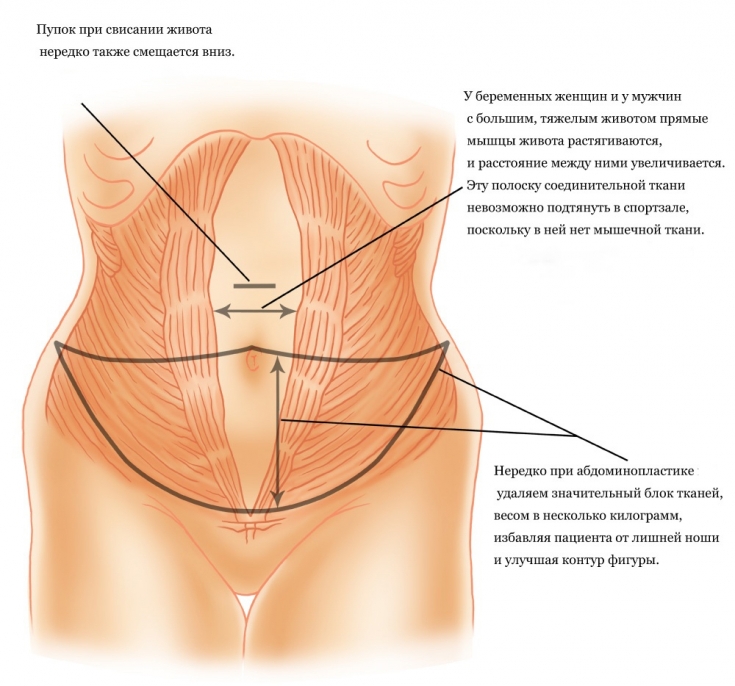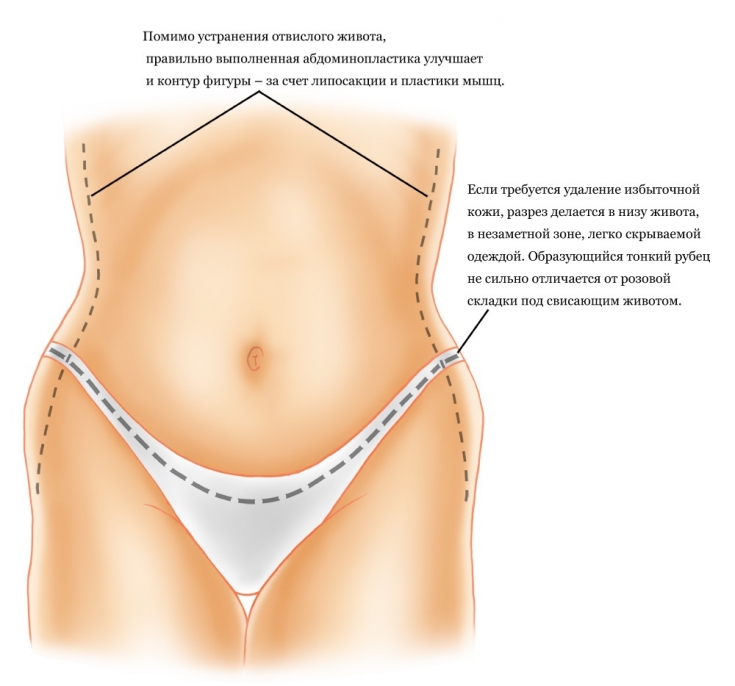One of the most problematic areas that prevent building a beautiful body in most people is the stomach. Modern beauty standards dictate a flat tummy (ideally — with muscular relief).
However, not all nature is given a beautiful belly due to physiological characteristics, and some lose the elasticity of this zone due to natural processes (for example, pregnancy and childbirth).
What to do if even a diet and proper nutrition do not help to remove a sagging tummy? Should I try surgical tummy tuck - abdominoplasty in this case? How is this operation performed and are there possible complications after it? Read our article!
1. Let's figure out who is indicated for a tummy tuck
2. Varieties of tummy tuck surgery and features of the procedure
3. How to prepare for a tummy tuck
4. Recovery period after tummy tuck
Let's figure out who is indicated for a tummy tuck
Abdominoplasty — is a surgical operation to correct imperfections in the skin of the abdomen and the anterior abdominal wall.
Corrected deficiencies can be different:
- flabbiness of tissues;
- skin defects (such as stretch marks or scars) that cannot be eliminated by other methods (such as laser resurfacing);
- excess subcutaneous fat;
- muscle defects (e.g. dehiscence).
Plastic surgery removes all these imperfections and deformities, giving the stomach a tight look and a neat shape.
Although tummy tucks are done for both men and women, the fair sex is more likely to turn to plastic surgeons for this service.
Apparently, it's the psychological aspect of the problem. Women are morally less able to tolerate their own unaesthetic appearance, which interferes with a quality life, not allowing them to relax and distract themselves from thoughts about their own imperfection.
Indications for abdominoplasty can be medical and psychological:
- stretch marks (stretch marks on the abdomen, most often occurring after pregnancy due to the natural lack of elasticity of the skin);
- diastasis (divergence) of the rectus abdominis muscles (in women it may occur after childbirth, and in men it may be triggered by excessive accumulation of internal or visceral fat);
- rough scars in the lower abdomen after operations;
- skin sagging on the abdomen (this can be observed not only after pregnancy, but also after a sharp weight loss or in very large volumes) - the so-called skin apron;
- prolapse of the anterior abdominal wall;
- excess fat deposits on the abdomen that do not burn even with diet and sports activities.
Please note: the emphasis is on the fact that only those people who conscientiously tried more gentle methods of fight for a beautiful stomach.
Proper nutrition, sports, massage, cosmetic and hardware procedures can easily cope with many problems. The main thing is not to be lazy.
After all, abdominoplasty is not a panacea. It will not solve the problem in the long term if you are not determined to follow all the rules after the operation.
Types of tummy tuck surgery and features of the procedure
Given that there are different indications for a tummy tuck, it is divided into several types.
Types of abdominoplasty:
1. classic;
2. endoscopic;
3. mini tummy tuck;
4. apronectomy;
5. abdominotorsorrhaphy.
The classic method of tummy tuck allows you to connect muscles, get rid of excess subcutaneous fat in the abdominal wall, tighten the skin by cutting off its excess areas. The navel may be moved. After classical abdominoplasty, the general contours of the figure are improved, the muscular corset is strengthened and the waist is reshaped.
The endoscopic method is indicated for patients who have normal skin, but weak abdominal muscles do not hold their shape. This is a more gentle intervention, as only a few punctures are made in the bikini area, and the endoscope is inserted in the navel.
Mini abdominoplasty, as the name suggests, is suitable for minor aesthetic correction of the skin. It is limited to the incision in the bikini area and does not affect other layers except the skin.
Apronectomy allows you to do everything: excise excess skin, remove fat deposits and even tighten the abdominal muscles. However, this requires an additional vertical cut.
The last type of correction with a complex name is the most extensive in terms of areas to be captured for correction. Abdominotorsorrhaphy allows to remove fat deposits not only on the abdomen, but also on the back, as well as on the hips, and at the same time get rid of skin defects.
How to prepare for a tummy tuck
The tummy tuck procedure usually lasts 1 to 1.5 hours and is performed under general anesthesia. The rehabilitation period after it takes 2-4 weeks.
This is a serious operation, which should only be carried out by experienced and proven specialists.
Otherwise, after tummy tuck, various complications may occur (bleeding, inflammation, infection of wounds with subsequent suppuration, loss of sensitivity in the area of operation, etc.).
It is also worth remembering that, like any surgical operation, a tummy tuck has its contraindications:
- infectious diseases;
- high blood pressure;
- blood clotting disorders;
- cardiac pathologies;
- thyroid pathology;
- diabetes mellitus.
Make sure you have no contraindications.
In any case, before the operation, the doctor will consult you and prescribe a series of tests that will help determine whether your body is ready for abdominoplasty.
Among them are several blood tests (general, biochemical, HIV and hepatitis, coagulogram) and an ECG. Anesthesiologist consultation is also required.
Two weeks before the procedure, you should stop taking hormonal drugs and medicines containing acetylsalicylic acid (aspirin).
One week before the procedure you should stop smoking, alcohol, spicy and fatty foods.
Rehabilitation period after tummy tuck
As we wrote above, the rehabilitation period will take from 2 weeks to a month — depending on the complexity of the abdominoplasty performed and the health of the patient.
In the first few days a person is left in the hospital under the supervision of doctors. Pain in the operated area is the norm, so painkillers are used. Antibiotics are also used to prevent inflammation from developing.
Compression bandage and maximum rest minimize swelling and speed up the healing process.
About the fifth day you are allowed to remove the bandage and leave the hospital for home. However, active life is still far away.
After 8-14 days the sutures are removed from the wound — and the person can return to normal life.
True, there are still some restrictions that must be observed. Within 2-3 weeks, you must comply with the prohibitions that were in effect before the operation (ban on alcohol, aspirin, specific food).
For a month after a tummy tuck, it is recommended to constantly wear compression underwear or a belt and avoid sharp bends or turns, and especially — weight lifting. For 2 months, you should refrain from active physical exertion, as well as visiting a sauna or bath and sunbathing.
Women are advised not to plan pregnancy for another 2 years after a tummy tuck surgery. So if you want a baby in the near future, think about it: are you ready to postpone pregnancy for a couple of years?
Tummy tuck — one of the most popular plastic surgeries in the world. For hundreds of thousands of people, abdominoplasty has restored the quality of life and self-confidence.
However, this is still a serious surgical intervention, so choose a doctor and the operation itself responsibly.
Also strictly follow the doctor's recommendations for rehabilitation. And do not forget about a healthy lifestyle, otherwise all efforts may go down the drain!
Facelift - a facelift that restores youth and beauty
You might be interested in: Abs Workouts.








Add a comment